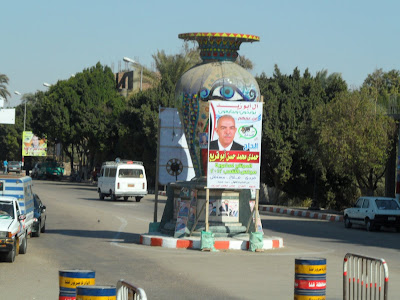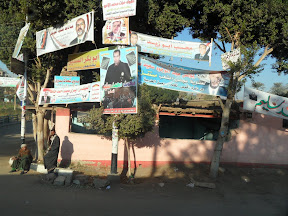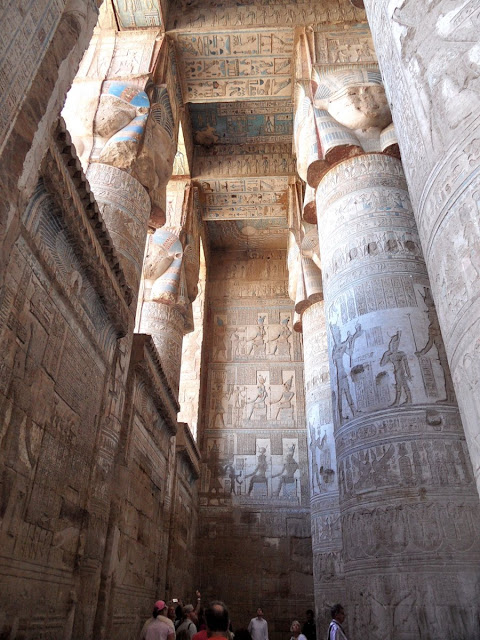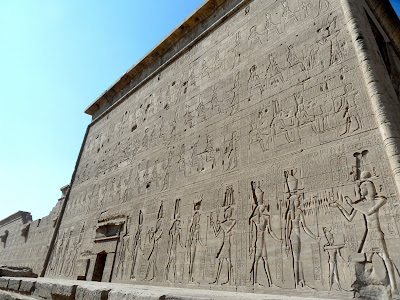 |
 |
 |  |
 |
Fields and villages briefly gave way to Qena, a large and modern-looking city in stark contrast to the lands we had just zipped through, and a little while after crossing the Nile on the eagle-themed bridge, we arrived at our destination.
Once through the ticket barriers, the complex makes you work for the views. A considerably long pathway was interrupted only by 90-degree turns around large square areas of ruined foundations nestled amongst green scrub. In the distance, a large and ominous trapezoid shape loomed up; a dark image contrasting with the bright and pleasant gardens bathed in the early morning sun. The building was fronted with large, thick stone columns and something was odd straight away - all the temples so far had a light and airy feel; being in such a ruined state they had little above them for the darkness to hide behind, but this place - the void between the columns was eerily dark. This place had a roof.
 |
The first thing you notice is the decoration; a long while ago the paint used to bring life to the reliefs of the various temples we had visited, had been worn away by thousands of years of sandblasting, plus an element of human interference no doubt. Only in relatively protected areas, such as the Valley of Kings we visited were there any traces of what Egyptian eyes would originally have seen. Here was a rare glimpse of very fragile art several thousand years old.
 |
 |
 |
Then Hani took us where we least expected - up a set of well-worn stone stairs around a spiralling square passageway until we finally arrived on the roof. We could see where we had just been, through the gaps in the massive stone blocks as we passed over them, the dim striplights below were dizzyingly far away and reminded you that what we were standing on had been there an awful long time, long after many other temple roofs had caved in.
Still, it felt pretty sturdy. The view over the sides of the semi-collapsed walls to the ruined temple grounds were otherworldly; a sea of millions of fragments of temple stone, shattered pottery and mounds of dry earth were punctuated by the foundations of buildings that were not as fortunate as Hathor temple when the revolutions came. In the distance, the heavily battered and near-disintegrated walls did little more than mark out the boundary of the old palace.
The views were impressively dystopian but that was not the reason Hani brought us up there. Taking us across the way we caught up with another crowd who were slowly dissipating under a covered area. As they made their way down the exit stairway we shuffled into the claustrophobic room, barely tall enough for some of the taller members such as myself to stand up straight. In my stooped position, I hadn't noticed the subject of Hani's latest talk - the Dendera Zodiac.
 |
Down through a dimly-lit staircase that seemed to go on for ever, we arrived back on the ground floor; Hani disappeared and we were all allowed to explore for a half hour or so. Dendera was an adventure playground of sorts, although with all sorts of health and safety violations. Little viewing rooms at the top of ladders, huge open areas to run around and of course the entrance yard stacked with huge pillars to hide behind. We admired the floor-to-ceiling murals and reliefs for a while until it all began to merge together and then we headed outside to get a closer look at the views we had seen from the rooftop.
 |
 |
 |
We got back on the bus and after a little bit of worried headcounting everyone was eventually accounted for and we headed back on the long journey to the Nile. Now mid-afternoon, the return journey took us down busier roads with individuals on either side of the pathless tarmac being brushed with vehicles of every size. Still the driver did not slow, not even after we passed a bus similar to our own with it's front end smashed in, which must have crashed not an hour or so earlier. We grabbed the armrests on our seats.
The early evening lights welcomes us back to the ship, and we had the rest of the day with no trips out planned. We ate our fill and then stretched out like beached whales on the bed. Ms. Plants was pooped but I was still in a shopping mood. Our hurried look around a papyrus shop the previous day piqued my interest for something to stick on the wall when I returned, and all these photos would have to be put somewhere, so maybe a market stall or tourist shop could satisfy my requirements.
Promising to only be gone an hour or so, I went alone off the ship, confident of my ability to not get murdered or bartered to death. Of course, not long after I started walking along the waterfront, I was spotted. Two young men slowed their horse and carriage and called out to me, asking where I was going. Simply going for a walk in the cool evening air wasn't something they believed a tourist would do for some reason, and so they pressed on, knowing my British sensibilities wouldn't allow me to ignore them for long.
I had gone my particular way to try out another shopping district, rather than visiting the market bazaar again. At the end of the promenade the map we were given told of tourist shops aplenty, but when I got there it was a sorry affair. A few tatty buildings - what looked to be the last of a line of shops that were being demolished as the Luxor refurbishments come in - were living out their swansong barely open and not containing anything other than a few faded postcards and some dusty ornaments. Even the shopkeepers seemed to have given up on the idea of actually selling anything and were sat on deckchairs outside, lacking the enthusiasm to get up and try and bother me.
So I turned round and headed back. And the horse and cart was waiting. My enthusiasm for finding anything worth buying had pretty much ebbed away to nothing, so I resigned to getting back on the ship. My guard down, I started to explain the situation to the men - who began talking enthusiastically of just the shop down the road, conveniently just too far to walk on foot.
So I bartered for a ride and, somewhat nervously, got on once we shook on a price. The cart started away and the ship disappeared into the night, away from the well-lit main streets and into the parts of the city the tourists don't usually see. We sided the body of the sphinx avenue and down dirt track roads, bustling with people getting the last things done before the night. Eventually, and just too far from the starting point to be comfortable, we pulled up at a well-lit, white building.
Promising to wait for me while I was inside (I fortunately hadn't paid them yet), this was a 'government building', which apparently meant it was cheaper and better quality than one of the dusty old shops I had seen on the seafront. Sure enough once through the entrance the building was transformed in much the same way as the Papyrus and Alabaster buildings Hani had shown us around earlier in the trip - clean, air-conditioned and tiled to within an inch of their lives, I had put my trust in the right people - it looked like the perfect spot for some tourist shopping.
On the ground floor was the Papyrus shop; paintings of all shapes and sizes on the walls; they all claimed to be half price in a sale which sounded a bit convenient, but the prices were pretty good so I wasn't about to complain, and since I was through the door and 'caught' now, the assistants new better than to badger me and kept back.
Eyeing a couple of possibilities I headed upstairs to the first floor, which was full of Alabaster and stone carvings, but no decent Ibis statue could be found. The top floor was full of clothing and rugs, the latter was too big to hulk back and nothing in the former looked good enough to wear. Somewhere along the way I managed to buy an overpriced photo album, with gold-leaf-style Egyptian artwork on a faux-leather cover. The papyrus people were happy enough when I bought a papyrus/lotus painting for my parents and a 'tree of life' print for my own spot.
To my relief the men were waiting patiently on my return and to even greater relief they honoured my decision to return to the ship rather than their suggestion of an extended tour, and even though they moaned a bit when I gave them twice what we agreed (I was feeling generous and it wasn't that much anyway) I'm glad I stuck my neck out and braved a little of the unknown. And yes, my inept bartering for the album was royally mocked upon my return.